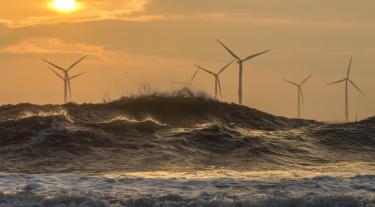After over two decades of European developments, the offshore wind industry is expanding to America and into the Asia-Pacific (APAC) region. Wind farm developers are currently facing the challenge of designing and building earthquake-resistant support structures for offshore wind turbines (OWTs), which requires reliable seismic analysis of the whole structural system and the soil.
DONISIS, a recent research project led by Delft University of Technology and set up in collaboration with the Carbon Trust’s Offshore Wind Accelerator (OWA) programme, will enhance the fundamental understanding of seismic soil-structure interaction mechanisms in monopile-founded OWTs.
In the common case of bottom-fixed OWTs founded on large/stiff monopile (MP) foundations, serious challenges are introduced by the complexity of non-linear MP-soil interaction, which may be accompanied by dynamic amplification phenomena, permanent soil deformations and, possibly, ground liquefaction. Notwithstanding the advances in the field of earthquake geotechnical engineering, several gaps must be filled for the optimisation of OWT support structures, to avoid over-conservatism in designing and overusing steel for fabrication. Such overuse is unsustainable from a resource perspective and may prevent an economic exploitation of offshore wind energy in seismic regions.
The DONISIS research will put emphasis on the role of non-linear soil behaviour and pore water pressure effects in seismic soil-structure interaction and will follow the CO.PH.FE.E. modelling approach, including centrifuge testing at Europe’s largest capacity research centrifuge at ETH Zurich, Switzerland.
The knowledge acquired throughout the research programme will feed into the development of a new one-dimensional seismic design model for monopile foundations, which will retain high accuracy while allowing fast design computations and swift research-to-practice transition in collaboration with the engaged industry partners.
Further, OWT seismic design recommendations and best practice guidelines for seismic monopile design will be developed based on the research results. Certification bodies DNV, Bureau Veritas and NCREE are involved from the very beginning to facilitate optimal dissemination of project results across the industry and potential standardisation uptake. The DONISIS project is also supported by a group of recognised leading experts in seismic engineering, soil structure interaction, and soil liquefaction (the “ITRP Representatives”), who will provide independent input and guidance to the project and ensure that latest research and knowledge are applied. The ITRP will be formed representatives from NCU Taiwan, UC Davis, Kyoto University the FLIP Consortium.
Partners:

Public funding:
Dutch Research Council NWO (Nederlandse Organisatie voor Wetenschappelijk Onderzoek)

Setup under:
Offshore Wind Accelerator (OWA)
Providing expertise as wind turbine OEM with their Offshore Engineering – Primary Support Structure department on detailed load calculations, integrated support structure design as well as advanced engineering tools and methods.


